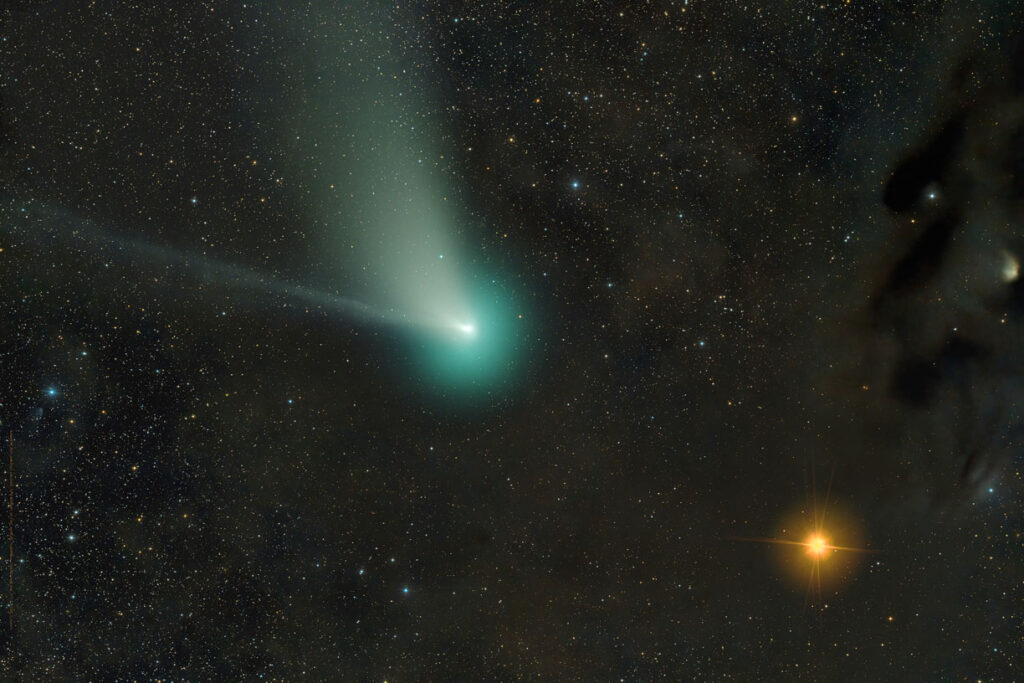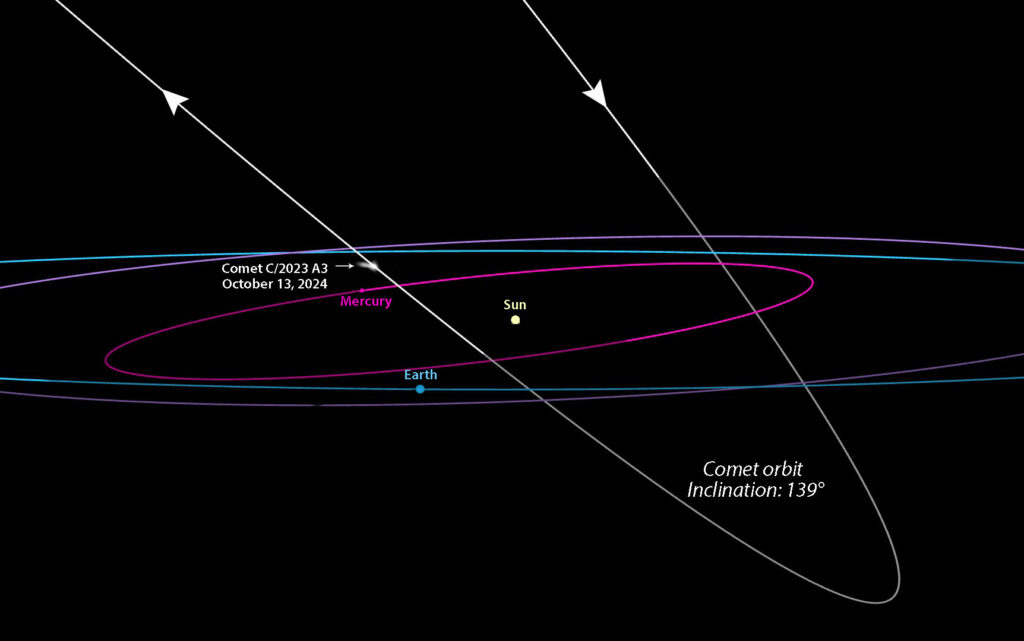Comet C2023 A3 Tsuchinshan – ATLAS
Comet C/2023 A3 (Tsuchinshan-ATLAS) is one of the most anticipated astronomical events in recent years, garnering attention from both professional astronomers and amateur stargazers alike. Discovered in early 2023, this comet is set to make a close approach to Earth in 2024, offering a rare opportunity to observe a celestial body from the outer reaches of the solar system. In this article, we will delve into the discovery, characteristics, and scientific significance of Comet C/2023 A3, while also touching on the excitement surrounding its appearance.

Discovery and Designation
Comet C/2023 A3 was discovered independently by two observatories: the Purple Mountain Observatory in China (Tsuchinshan) and the ATLAS (Asteroid Terrestrial-impact Last Alert System) survey. The discovery was first made on January 9, 2023, when a faint, previously unobserved object was detected in the constellation Serpens. Following confirmation of its trajectory and properties, it was designated C/2023 A3 (Tsuchinshan-ATLAS) to acknowledge both discoverers.

https://skyandtelescope.org/astronomy-news/anticipating-comet-tsuchinshan-atlas-c-2023-a3
Orbital Path and Approach
Comet C/2023 A3 is classified as a long-period comet, meaning its orbit around the Sun takes thousands of years. Preliminary orbital calculations indicate that it originated from the Oort Cloud, a distant region of icy bodies located far beyond the orbit of Neptune. The comet’s orbit is highly eccentric, taking it on an elongated path around the Sun. It is expected to make its closest approach to the Sun (perihelion) on October 12, 2024, coming within approximately 58 million kilometers (36 million miles) of the Sun—slightly closer than the orbit of Mercury.
Before reaching perihelion, C/2023 A3 will make its closest approach to Earth on October 13, 2024, at a distance of about 70 million kilometers (43 million miles). This relatively close proximity means that the comet could become visible to the naked eye in both the northern and southern hemispheres, offering an exciting opportunity for skywatchers worldwide.

https://skyandtelescope.org/astronomy-news/anticipating-comet-tsuchinshan-atlas-c-2023-a3
Physical Characteristics
Comets are often described as “dirty snowballs,” consisting of a mixture of water ice, frozen gases, and dust. When they approach the Sun, the increase in temperature causes the ice to sublimate, releasing gas and dust into space and creating the characteristic glowing coma and tail. Comet C/2023 A3 is no exception, and as it nears the Sun, it is expected to develop a bright, visible tail that could stretch for millions of kilometers across the night sky.
While detailed observations of C/2023 A3 are still ongoing, early estimates suggest that its nucleus— the solid core of the comet— could be several kilometers in diameter. The brightness of a comet is notoriously difficult to predict, but if current projections hold, C/2023 A3 could become one of the brightest comets seen in recent years, potentially rivaling Comet NEOWISE, which dazzled observers in 2020.
Scientific Significance
Comets like C/2023 A3 provide a unique window into the early solar system. Because they spend most of their time in the outer solar system, far from the Sun’s heat, comets preserve materials that have remained largely unchanged since the formation of the solar system about 4.6 billion years ago. Studying these objects can provide invaluable clues about the conditions that existed in the early solar system and the processes that led to the formation of planets.
As C/2023 A3 makes its approach, astronomers are particularly interested in studying its composition. By analyzing the gases released by the comet, scientists can determine its chemical makeup, including the presence of molecules such as water (H₂O), carbon dioxide (CO₂), carbon monoxide (CO), and various organic compounds. The discovery of complex organic molecules on comets has fueled speculation about their role in delivering the building blocks of life to early Earth.
In addition to chemical studies, astronomers are keen to investigate the physical structure of the comet’s nucleus and its activity levels as it approaches the Sun. Observing how the comet’s surface changes in response to solar heating can provide insights into the evolution of comets over time and help refine models of cometary behavior.
Historical and Cultural Context
Comets have captivated human imagination for millennia. Often regarded as omens or harbingers of significant events, they have been recorded in ancient texts and depicted in art throughout history. Modern science, of course, has demystified many of these ancient beliefs, yet the appearance of a bright comet in the night sky still evokes a sense of wonder.
C/2023 A3 is unlikely to disappoint in this regard. As it becomes visible in 2024, it may become a cultural phenomenon, much like Halley’s Comet or Comet Hale-Bopp, both of which captivated the public when they made their appearances. The comet’s journey will undoubtedly inspire a renewed interest in astronomy and space exploration, particularly as space agencies continue their missions to study comets and other small bodies in the solar system.
Observing the Comet
For those eager to witness Comet C/2023 A3, it is expected to be most visible in the weeks surrounding its closest approach to Earth in October 2024. During this time, it could become visible to the naked eye, but even small telescopes or binoculars will provide a clearer view of its nucleus and tail. Skywatchers in both the northern and southern hemispheres should have a chance to observe the comet as it traverses the sky.
Astrophotographers will undoubtedly be drawn to the opportunity to capture the comet’s glowing tail and its passage against the backdrop of stars. For observers with access to darker skies, away from city lights, the comet may even be a stunning sight visible without optical aids.
Conclusion
Comet C/2023 A3 (Tsuchinshan-ATLAS) offers a rare and thrilling opportunity to witness a cosmic visitor from the far reaches of the solar system. Its appearance in 2024 could provide significant scientific insights into the composition and behavior of comets, as well as serve as a visual spectacle for skywatchers around the globe. As we approach this celestial event, anticipation continues to build, reminding us of the wonder and mystery of the universe beyond our planet.
